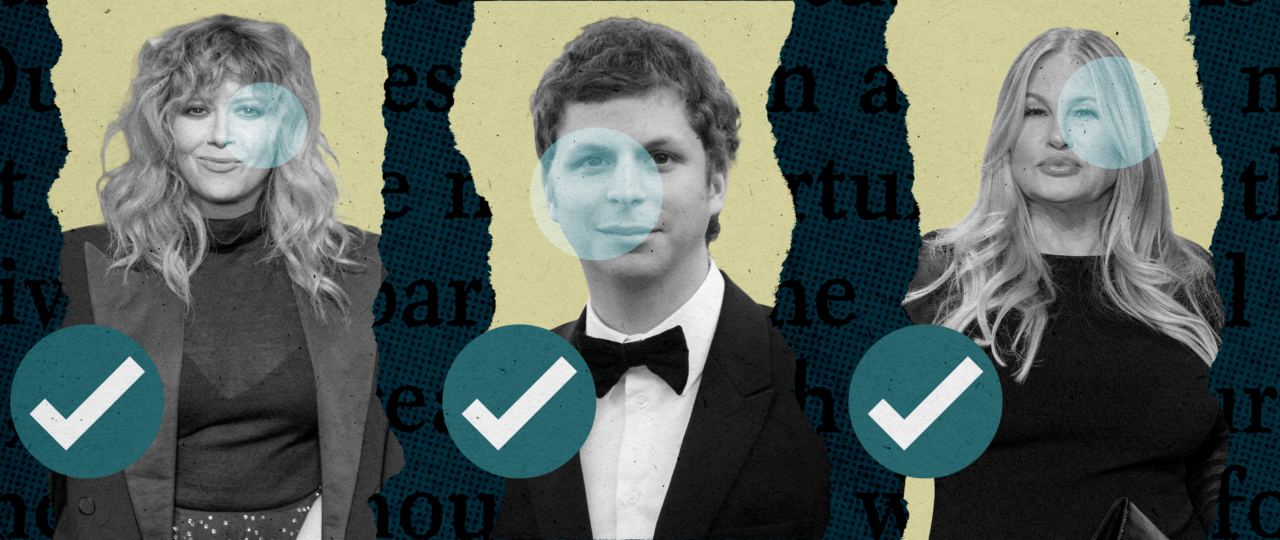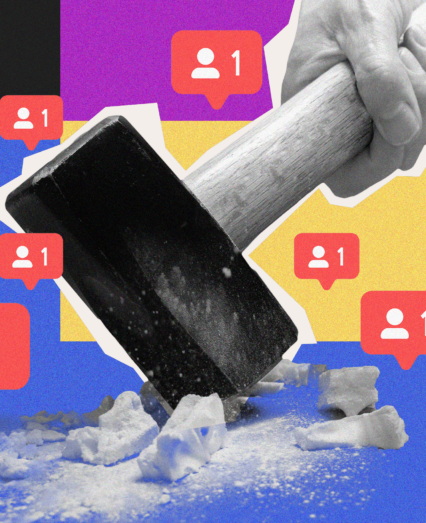Everywhere I turn I’m seeing celebrities representing brands again—whether it’s billboards, social media, or TV ads. But wasn’t it just about a year or so ago that everyone swore celeb endorsements were dead? We all thought that user generated content (UGC) was the new ride-or-die marketing tactic for brands.
Well, unfortunately, the last few years have seen a whole host of internet drama surrounding dishonest content creators. From a travel influencer photoshopping the same clouds on all her photos, to “Mascaragate,” where beauty influencer Mikayla Nogueira put on false lashes to promote a mascara (fellow creator Madison Lewis didn’t help matters when she said she would do the same thing if a brand “put $200,000 in her face”). Suffice to say, people are losing trust in influencers and falling back to what they’re already familiar with: celebrity endorsements.
While the industry is going back to a classic strategy, it’s been notable to see a lot of fresh faces this time around. As audiences change so do the celebrities they relate to, and the common thread we’re seeing is more niche celebrities being allowed to do what they do best, often centered around out-of-pocket humor that’s no doubt geared toward Millennial and Gen Z buyers. Rather than reading off a corny script, these celebs are clearly involved in the creative process and putting a bit of themselves in these new endorsements, makes the ads feel more authentic than they have in the past.
We know celebrity endorsements work because there is data showing that company sales increase an average of 4% relative to competition when the tactic is used. Neuroscientist and entrepreneur Jeff Stibel says the reason for this is because our minds struggle to differentiate between real and make-believe, so the familiarity of a celebrity benefits a brand. “When a familiar face promotes a product, it makes it seem as if the product itself is familiar, which makes people more likely to buy it. Even though we’ve never met them, the brain regards familiar celebrities the same way it does people who are actually familiar and trustworthy to us in real life.”
Can you say the same about content creators you’re familiar with? Yes! But I think there’s something to be said about money too. Going back to what Madison Lewis’ comment, I’m more likely to think a content creator needs that cash, where a celebrity, presumably, already has plenty. Therefore logic concludes Danny DeVito must actually love Jersey Mike’s subs, because why would he bother if not?
But I’m getting ahead of myself. Let’s talk through some of the recent celebrity endorsements that have a fresh new take on the tactic.
Michael Cera – CeraVe
If you don’t already know who Michael Cera is, you will after watching his CeraVe ad, which debuted during Super Bowl LVII. This ad had some people bewildered, others rolling out their seats in laughter, and the internet buzzing. If there’s one thing advertisers got right on this one, it was the shock factor. It’s weird and absurdist, but oh so memorable—just like many of the characters we’ve seen him play over the years. While Super Bowl ads are known for being high-budget and outrageous, and a celebrity feature for one is nothing new, it’s the Michael Cera factor that really stands out on this. He’s no superstar, and he’s admittedly funny looking, but he’s a big draw for that Millennial/Gen Z demographic who grew up with him.
Natasha Lyonne – Old Navy
I won’t lie—I’m not the biggest movie/TV buff. So while most people know Natasha Lyonne from her roles in American Pie, Orange is the New Black, or Netflix’s latest Lyonne hit, Russian Doll, I only know her from this specific Old Navy commercial. It’s an interesting choice to put this indie darling in a big brand endorsement, but again, I’m more likley to know her than my dad is, and even though I didn’t recognize her in this case, she brings an undeniable “cool” factor for a brand I still associate with American flag flip-flops. There’s just something catchy about the way she says “Natasha?” and “Wow!” over and over. To top it off, the way she says, “Thanks, it’s from Old Navy,” really does encapsulate how it feels telling someone your outfit is from Old Navy.
Check out her whole series of Old Navy commercials here.
Joe Jonas – Xeomin
We had to throw in one example that does have a corny script. I don’t follow the Jonas Brothers closely, but one thing that doesn’t come to mind when I think of them is Botox (*cough* Zac Efron) or any other kinds of injectables. So why is Joe Jonas trying to sell me Xeomin, a Botox alternative? Again, let’s look back to the audiences most likely to care about him, which are… yes, Millennials and Gen Z. As Botox injections are getting targeted to younger and younger groups, this brand partnership makes a lot of sense, and I suppose there’s something progressive about the messaging that men shouldn’t be ashamed to talk about getting injectables too, but it was still a weirdly jarring commercial the first time it came across my feed.
SZA – Skims
Dissecting the history of Skims marketing could be a blog in itself, but they really started catching my eye last summer. Several bus shelters around the city had ads of different celebrities modeling Skims underwear—those most memorable for me were SZA and Doja Cat. For a brand that formerly had no OOH marketing, and one so closely identified with its creator, Kim Kardashian, to see other celebrities (with a decently diverse cast of models—at least in comparison to its competitor, Victoria’s Secret) suddenly touting the brand certainly stood out. Other celebs who have modeled for the brand since include Chelsea Handler, Brooke Shields, Becky G, Usher, Neymar Jr., and many more. The variety in gender, age, size, and race across the brand’s marketing works with a two-prong approach: fans of the Kardashians who may not have cared about those celebrities will now care, and fans of those celebrities who may not have been fans of the Kardashians are more likely to try the brand now. Win/win for brand and endorsers alike!
Arnold Schwarzenegger & Danny DeVito – State Farm
Having grown up in a multilingual household, this State Farm commercial that pokes fun at Arnold Schwarzenegger’s accent is especially funny to me. My siblings and I have tried to correct the way our parents say certain words over and over (for years!), to no avail, and this commercial captures that humor perfectly. Not sure what Schwarzenegger and DeVito have to do with insurance (unlike DeVito’s relationship with Jersey Mike’s, which makes perfect sense), but the humor makes this ad entertaining every time, and it’s heartwarming to see this classic duo together again (Twins, anyone?). And I know I don’t need to explain to you young hip Philly people why DeVito will always be loved across any age group.
Jennifer Coolidge – e.l.f. Cosmetics
If there’s any brand that’s tapping into humor and pop culture, it’s e.l.f. Cosmetics. This drugstore brand got a lot more appealing after nabbing White Lotus star and internet favorite Jennifer Coolidge. Another Super Bowl commercial, this one’s a beautiful example of letting the celebrity truly be themself in a way the audience is going to love, as Coolidge had previously revealed she always wanted to play a dolphin.
Broad City – MiraLAX
Millennial humor at its peak is the infamous Broad City. Choosing Abi Jacobson and Iliana Glazer as the face for the latest MiraLAX campaign, a constipation powder, is SO on brand for the comedy duo it’s almost scary. It’s an especially interesting choice since the show ended five years ago, so you know they’re really banking on the existing fan base tapping in more than cultural relevancy. It reads like a typical sketch from them, that just happens to have MiraLAX in it. It harkens back to the days of cell phones in music videos.
Looking forward, I think celebrity endorsements are here to stay, and I’m here for it. I think they’re funny, memorable, and most importantly, relatable to a brand’s key audience. I still think UGC is a strong tactic in some scenarios, but there are times when it makes sense to use a familiar face that receives less skepticism from people. These two tactics will compete for #1 over the years, and trends will come and go, but it all boils down to the audience you’re trying to reach, so marketers—choose carefully!



